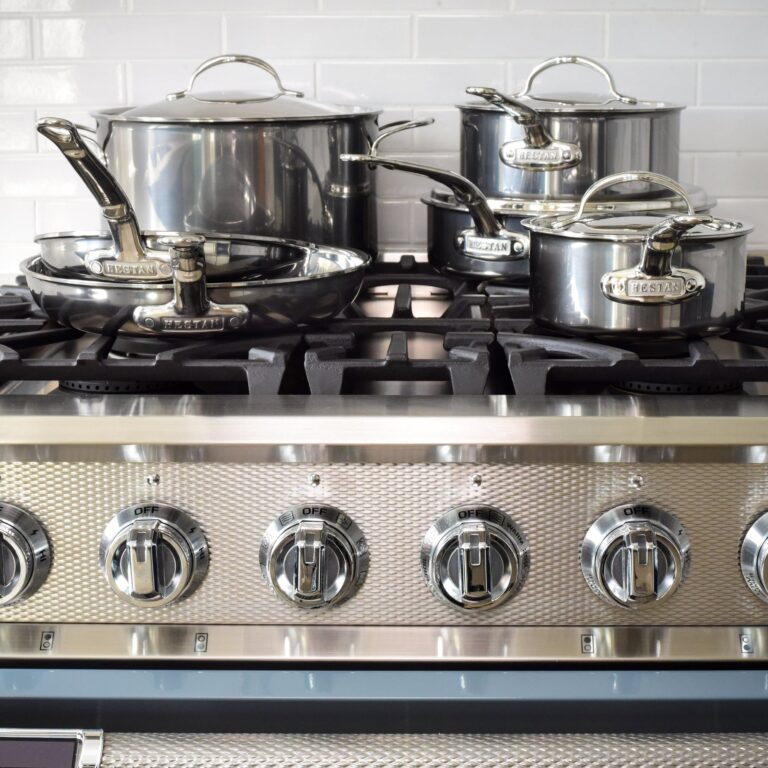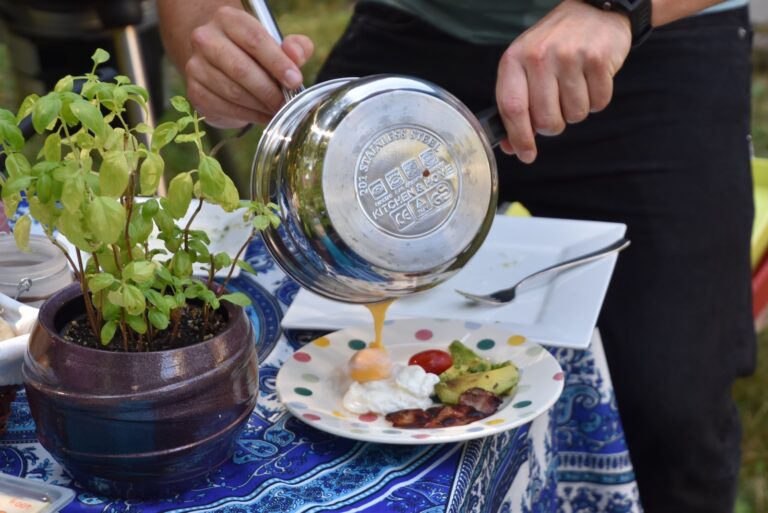I love cooking with cast iron pans, but over time, they can lose their seasoning and become less effective. That’s why I want to share my tips on how to reseason your cast iron pan.
In this article, I’ll guide you through the process step by step, from gathering the necessary tools to troubleshooting any seasoning issues that may arise.
With a little care and maintenance, you’ll have a perfectly seasoned pan for years to come.
Let’s get started!
Key Takeaways
- Regular reseasoning maintains the durability and non-stick properties of a cast iron pan.
- Cleaning and stripping the pan is essential for removing old seasoning and restoring its non-stick surface.
- Applying and maintaining a seasoning layer involves thoroughly cleaning and drying the pan before applying oil, and regularly applying a thin layer of oil after each use.
- Avoid common mistakes such as using too much oil, not properly cleaning the pan before reseasoning, skipping the preheating step in the oven, and storing the pan while it’s still damp or wet.
Why Reseasoning Your Cast Iron Pan Is Important
Why reseasoning your cast iron pan is important is because it helps maintain its nonstick surface and prevents rust.
As someone who loves cooking, I rely on my cast iron pan for many of my favorite dishes. Over time, however, the seasoning can wear off and the pan may start to stick. That’s where reseasoning comes in.
By applying a thin layer of oil and heating it in the oven, you create a new layer of polymerized oil that restores the nonstick properties of the pan. This process also helps prevent rust by sealing any exposed metal surfaces.
Regularly reseasoning your cast iron pan not only prolongs its lifespan but also enhances its performance, ensuring that your meals turn out perfectly every time.
Gathering the Necessary Tools and Materials
To gather all the necessary tools and materials, you’ll need a wire brush, dish soap, water, paper towels, and vegetable oil.
I love using my cast iron pan for cooking because it gives food a delicious flavor and retains heat really well. However, over time, the seasoning on the pan can wear off and it needs to be reseasoned. Don’t worry though; reseasoning your cast iron pan is easy!
By following these simple steps and using the right tools and materials, you’ll have your pan looking good as new in no time.
- Wire brush: This will help you remove any rust or food particles from the surface of the pan.
- Dish soap: Use this to give your pan a thorough cleaning before reseasoning.
- Water: You’ll need this to rinse off your pan after scrubbing it with dish soap.
- Paper towels: These are great for drying off your pan after rinsing.
- Vegetable oil: This is what you’ll use to season your cast iron pan and create that non-stick surface.
Cleaning and Stripping the Pan
When it comes to cleaning and stripping a cast iron pan, there are key points to consider: seasoning removal methods and the best cleaning techniques.
In my experience, I’ve found that using a combination of heat, oil, and coarse salt works well for removing old seasoning.
Additionally, scrubbing the pan with a stiff brush or chainmail scrubber can help remove any stubborn residue.
Seasoning Removal Methods
If you’re looking to remove seasoning from your cast iron pan, one option is using a mixture of vinegar and water. It’s a simple and effective method that I often use when I want to start fresh with my cast iron cookware. Here are some reasons why this method works:
- Easily removes built-up grease and residue
- Safe and non-toxic alternative to harsh chemicals
- Restores the pan’s natural non-stick surface
- Helps eliminate any lingering odors
- Prepares the pan for reseasoning
To use this method, simply mix equal parts of white vinegar and water in a large container or sink. Submerge the pan in the mixture for about an hour or longer if needed. Scrub gently with a sponge or brush to remove any remaining seasoning. Rinse well with warm water, dry thoroughly, and proceed with reseasoning as desired.
Best Cleaning Techniques
For the best cleaning techniques, make sure you gently scrub the surface with a sponge or brush to remove any remaining residue. This step is crucial in maintaining the quality of your cast iron pan.
I usually start by rinsing it with warm water to loosen any stuck-on food particles. Then, I apply a small amount of dish soap and use a non-abrasive sponge or brush to gently scrub away any grease or grime. It’s important not to use harsh chemicals or abrasive materials as they can damage the seasoning on the pan.
Once I’m satisfied with the cleanliness, I rinse off all the soap and dry it thoroughly with a towel.
Following these simple steps ensures that my cast iron pan stays in excellent condition for years to come.
Applying the Initial Seasoning Layer
To season your cast iron pan, you’ll want to start by applying a thin layer of oil. This step is crucial in creating a non-stick surface and enhancing the longevity of your beloved cookware. Here’s how I do it:
- Use a neutral oil like vegetable or canola oil for best results.
- Make sure to thoroughly clean and dry your pan before starting the seasoning process.
- Apply the oil all over the pan, including the handle and both sides if it’s a two-sided griddle.
- Use a paper towel or cloth to evenly spread the oil, ensuring every nook and cranny is covered.
- Don’t be afraid if it looks too oily at first; it will all soak in during the heating process.
Maintaining and Caring for Your Seasoned Pan
Now that I’ve learned how to apply the initial seasoning layer to my cast iron pan, it’s important to know how to maintain and care for it properly.
First, I’ll make sure to always hand wash my pan using hot water and a brush. Using soap is a big no-no as it can strip away the seasoning.
After washing, I’ll dry it thoroughly with a towel or by placing it on the stove over low heat.
To prevent rusting, I’ll apply a thin layer of oil after each use and store it in a dry place.
If any food residue sticks to the surface, I’ll gently scrub it off with salt or a non-abrasive scrubber.
With regular maintenance and care, my seasoned cast iron pan will last for years to come!
Troubleshooting Seasoning Issues
If you’re experiencing issues with the seasoning on your seasoned pan, try adjusting the temperature when applying the oil. This simple tweak can make a big difference in achieving a smooth and durable seasoning layer.
Here are five tips to help troubleshoot any seasoning problems you may be facing:
- Use high smoke point oils like vegetable, canola, or flaxseed oil for better results.
- Make sure to preheat your pan before applying the oil to ensure an even distribution.
- Apply multiple thin layers of oil instead of one thick layer to prevent uneven coating and pooling.
- Avoid cooking acidic foods like tomatoes or citrus fruits until your seasoning is well-established.
- Regularly clean and dry your pan after each use to maintain its seasoning and prevent rusting.
Tips for Achieving a Perfect Seasoning
Achieve a perfect seasoning on your pan by using high smoke point oils like vegetable, canola, or flaxseed oil and applying multiple thin layers for an even coating. I find that these oils work best because they can withstand high temperatures without breaking down.
To start the process, I heat my cast iron pan on low heat to open up its pores. Then, I apply a thin layer of oil using a paper towel or brush, making sure to cover every surface including the handle.
After that, I place the pan in a preheated oven at 400°F for about an hour. Once it’s done baking, I repeat this process several times to build up a durable and non-stick seasoning.
How Often Should You Reseason Your Cast Iron Pan
It’s important to regularly season your cast iron to maintain its durability and non-stick properties. As a home cook who loves using cast iron pans, I can’t stress enough how crucial it is to reseason them periodically.
Here are five reasons why you should make reseasoning a regular part of your cast iron maintenance routine:
- Prevents rust: Reseasoning creates a protective layer on the surface of the pan, preventing rust from forming.
- Enhances seasoning: Over time, the seasoning on your cast iron can wear off. Reseasoning helps build up the layers and improves its non-stick capabilities.
- Removes odors: If your cast iron has absorbed strong food smells, reseasoning can help eliminate them.
- Restores shine: Reseasoning gives your pan that beautiful dark and shiny appearance that we all love.
- Maintains longevity: Regularly reseasoned cast iron pans can last for generations if properly cared for.
Exploring Different Seasoning Methods
To explore different seasoning methods, I can experiment with various oils and cooking techniques to find the best way to maintain a non-stick surface on my beloved cookware.
One method I’ve found effective is using vegetable oil and baking my cast iron pan in the oven. I preheat the oven to 400°F, then apply a thin layer of vegetable oil to the entire surface of the pan. After that, I place it upside down on the middle rack of the oven and let it bake for an hour. Once it’s done, I turn off the oven and let the pan cool inside.
This process helps create a smooth and durable seasoning layer that prevents food from sticking. It takes some trial and error, but finding your preferred method can make all the difference in maintaining a well-seasoned cast iron pan.
Conclusion
In conclusion, reseasoning your cast iron pan is an important step in maintaining its performance and longevity. By following the necessary steps and using the right materials, you can easily clean, strip, and apply a new seasoning layer to your pan.
Remember to regularly maintain and care for your seasoned pan to prevent any issues. With a little troubleshooting and some helpful tips, achieving a perfect seasoning is within reach.
How often you should reseason will depend on your usage, but exploring different seasoning methods can also be fun and rewarding.



